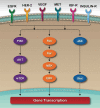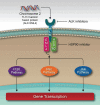Promising new treatments for pancreatic cancer in the era of targeted and immune therapies
- PMID: 31598392
- PMCID: PMC6780661
Promising new treatments for pancreatic cancer in the era of targeted and immune therapies
Abstract
Pancreatic ductal adenocarcinoma (PDAC) is the fourth leading cause of cancer mortality among men and women in the United States. Its incidence has been on the rise, with a projected two-fold increase by 2030. PDAC carries a poor prognosis due to a lack of effective screening tools, limited understanding of pathophysiology, and ineffective treatment modalities. Recently, there has been a revolution in the world of oncology with the advent of novel treatments to combat this disease. However, the 5-year survival of PDAC remains unchanged at a dismal 8%. The aim of this review is to bring together several studies and identify various recent modalities that have been promising in treating PDAC.
Keywords: BRCA; Pancreatic cancer; cancer vaccine; check point inhibitor; hypoxia induced resistance; immunotherapy; targeted therapy.
AJCR Copyright © 2019.
Conflict of interest statement
None.
Figures
References
-
- Siegel RL, Miller KD, Jemal A. Cancer Statistics, 2017. CA Cancer J Clin. 2017;67:7–30. - PubMed
-
- Zhou J, Enewold L, Stojadinovic A, Clifton GT, Potter JF, Peoples GE, Zhu K. Incidence rates of exocrine and endocrine pancreatic cancers in the united states. Cancer Causes Control. 2010;21:853–861. - PubMed
-
- Fesinmeyer MD, Austin MA, Li CI, De Roos AJ, Bowen DJ. Differences in survival by histologic type of pancreatic cancer. Cancer Epidemiol Biomarkers Prev. 2005;14:1766–1773. - PubMed
-
- Hruban RH, Takaori K, Klimstra DS, Adsay NV, Albores-Saavedra J, Biankin AV, Biankin SA, Compton C, Fukushima N, Furukawa T, Goggins M, Kato Y, Kloppel G, Longnecker DS, Luttges J, Maitra A, Offerhaus GJ, Shimizu M, Yonezawa S. An illustrated consensus on the classification of pancreatic intraepithelial neoplasia and intraductal papillary mucinous neoplasms. Am J Surg Pathol. 2004;28:977–987. - PubMed
Publication types
LinkOut - more resources
Full Text Sources


